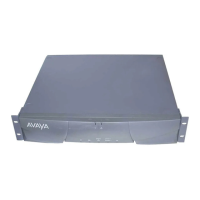Isolating and Repairing Packet-Bus Faults
Issue 1 May 2002
4-87555-233-143
TN771D Maintenance/Test — A Maintenance/Test board’s fault may
either:
— Falsely indicate a packet-bus fault
— Cause the inability to detect such a fault
If the test board’s fault is on its packet-bus interface, the packet bus may
also be alarmed.
Failure of any circuit pack’s bus interface may alarm the packet bus due to
shorting of packet-bus leads. This typically disrupts all packet-bus traffic in the
affected PN. Some packet-bus faults do not affect every endpoint, so a
packet-bus fault cannot be ruled out just because some packet service is still
available.
A circuit pack can fail in such a manner that it sends bad data over the packet bus.
If this occurs on an:
■ IPSI’s Packet Interface circuit, all packet traffic within the IPSI-connected
EPN and its scope are disrupted.
■ EI circuit pack may disrupt all packet traffic in its EPN.
■ ISDN-BRI circuit pack, every device connected to the circuit pack fails to
function.
This failure may also disrupt the entire packet bus whenever the circuit pack tries
to transmit data. Such a disruption may be indicated by:
■ Intermittent packet-bus alarms
■ Intermittent failures of other packet circuit packs
■ Interference with other connected endpoints
These failures are difficult to isolate because of their intermittent nature. In most
cases, the failed circuit pack is alarmed, and every connected endpoint on the
circuit pack is out of service until the circuit pack is replaced. These symptoms
help in isolating the fault.
Maintenance of the Packet Bus
The following topics are covered in this section:
■ ‘‘Comparing Packet and TDM Buses’’
■ ‘‘Packet Bus maintenance software’’ on page 4-89
■ ‘‘Overview of Fault Correction Procedures’’ on page 4-90

